On behalf of GreenPAC, pvbuzz.com sat down with cleantech entrepreneur Tom Rand from MaRS Discovery District to talk about climate solutions and the relationship between the Canadian government and the country’s emerging cleantech industry.
Clean technology or ‘cleantech’ for short—is a relatively new industry encompassing economically compelling and environmentally friendly technologies, products, and services. The cleantech industry can be a major driver for new investments and job growth in Canada. Today, the country gears up to become a cleantech leader. But to achieve this, effective public policy efforts are needed to support R&D that ensure ideas are tested and made readily deployable for a sustainable and economic future.
Interest from venture capital towards cleantech has steadily increased over the last several years because of a huge shift in the economics of the environmental industry. The fact that technology in the cleantech industry has quickly developed to the point of becoming almost cost-competitive with traditional methods of producing energy makes it worthwhile—not just for the environment, but also financially.
Worldwide efforts to address environmental problems such as global warming, air pollution, water pollution, and increased energy use are on the rise. This confluence of forces—the simultaneous maturity of both environmental technology and impetus—makes cleantech a promising sector for future growth.
— The NRDC
It goes without saying that cleantech innovation and good policy can promote job growth and a healthy environment at the same time. Through effective policy, cleantech ideas and companies that invest resources to advance these technologies can be funded. But to get effective policy, we need people sympathetic to the cause in power, and others who publicly back the process and bring it mainstream.
There are indeed great leaders in the cleantech sector—from scientists, to technologists, to investors, to entrepreneurs—and they’re making real impacts during a time when renewable energy finally has gained some momentum and start-ups are focusing more on their environmental efforts.
One of such leaders is Tom Rand.
Tom started his career as a software renegade in high school. Then he went legit and founded Voice Courier Inc. (VCi) in 1991 to service the emerging Interactive Voice Response market. Tom led VCi’s expansion to over 100 employees in three countries, with revenue in excess of US$25 million annually. The VCi Group of Companies was profitable for each of the 12 years it was under his control, and was sold in the spring, 2005. Tom has been active in the cleantech sector both as a venture capitalist and from a policy perspective, so he understands the challenges entrepreneurs face. His focus at MaRS is on new ventures based on low-carbon technologies and the supporting infrastructure, such as renewable energy and energy efficiency.
As part of one of many efforts to support GreenPAC‘s work in translating Canadians’ environmental concerns into political action, PVBuzz’s Editorial Manager Derick Ajumni met with Tom Rand at his downtown Toronto MaRs office for coffee and a chat. This interview has been published on GreenPAC’s website as a three part series.
MaRs Cleantech
Derick: So let’s talk a little bit about MaRs, what is it and what does it do?
Tom Rand: The best way to think about MaRS Discovery District is—we are trying to put Silicon Valley in a building here in downtown Toronto. Canada generates intellectual property, per capita at the same rate as our American cousins, Boston, New York and San Francisco, but we don’t generate the same economic activity from that intellectual property. We generate roughly one tenth of the capital of the jobs per capita than our American cousins. And so MaRs is here to solve that problem and we solve that problem in a number of ways with some complexity. But we really have three focuses: life sciences, IT and cleantech.
I founded the cleantech practice back in 2009, the mandate there being to find the best and brightest ideas within cleantech companies and help them find capital, hit global markets and become dominant players in that sector.
The Perspective
Derick: Paint us a picture of what the new economy looks like here in Canada?
Tom Rand: Historically, we made a lot of money in mining, petrochemicals and oil. What I’m trying to do is think about Canada’s role in the low carbon economy. As the world transitions to a low carbon economy, how is Canada going to play there? Are we going to get a net benefit from that transition?
So in my mind, jurisdictions will be net sellers or net buyers of low carbon technology. That transition is coming whether one wants to believe in climate [change] or not, the world is de-carbonizing. Canada has a choice, we will either work very hard to develop our innovation around clean energy technology and ensure that we are selling that technology to the rest of the world or we would end up buying it.
If Canada gets just 2%—which is our pro-rata share of global emissions—of the clean energy market, our clean energy sector would be as big as our automobile sector. Two percent of what we should get for just showing up, I think that’s the minimum we should be thinking about. If we think about our universities, our research, the ability to raise capital, our expertise in energy — even though it is ‘old school’ energy, there is no reason we can’t get a much bigger piece of that pie.
“I’m trying to make an economic argument around Canada’s role in helping solve the climate problem. There is an economic upside, we can claim that space, and we are claiming that space. Right now cleantech employs more people than the Alberta tar sands.
Today, clean energy technology companies are dominated by what they call SME (small and medium-size enterprises) they are not big public companies yet, they are small and are growing but there are many of them. They spend more on research and development (R&D) than the entire oil and gas sector. Think about that for a moment. You want to think about what the future economy would be composed of, look to where the R&D money is flowing because that’s next-generation technology; not yesterday’s technology. Canadian cleantech companies spend more on R&D in absolute terms than the entire oil and gas sector in this country.
That piece of the Canadian economy is healthy but that does not mean it will remain healthy. This is a very difficult market to enter, because of its energy and its infrastructure, it requires a lot of financial backing, it requires strong capital and access to global markets. So as we are transitioning from a start-up economy—cleantech economy—as these companies mature and enter the global scene, an ecosystem that supports them is critical.
I would note that no industry of any size, automotive, the internet, aerospace, nuclear, medicine, none of those industries were invented ‘de novo’—out of nothing—in someone’s garage by the private sector. There was always strong strategic public support for those sectors. Cleantech is no different, so the idea that cleantech is going to come out of the woodwork and suddenly develop into a trillion dollar industry by itself, not going to happen. Other governments are being very strategic about how they support their industries and Canada needs to do the same thing.
The Technology
Derick: What are some of the most exciting game-changing technologies and how might they change our lives in the next decade?
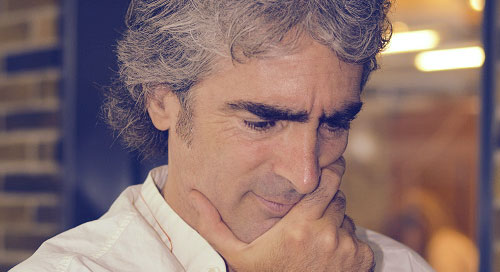
Tom Rand—Cleantech Investor, Advisor, Speaker, Author, Entrepreneur reflects during a pause while answering a question from PVBuzz. Photo by Derick Ajumni
Tom Rand: Well there are two pieces to that. One is simply that the cost of renewable energy is decreasing very rapidly, it dropped almost 80% in the last four or five years. It’s at grid parity in many parts of the world and those regions would increase their capacities. That’s very exciting and Canada’s got some great horses in that race. Morgan Solar, for example, will be the lowest cost solar energy producer on the planet later this year.
What’s also interesting though is energy storage. Skeptics complain that the sun does not always shine, the wind does not always blow—yeah! So in order to address this, energy storage is in my mind the ‘holy grail’ of renewable energy. Tesla’s announcement of the Power Wall was exciting and will obviously play a big role in energy storage but we already have Hydrostor in Canada, underwater compressed air; which is the lowest grid scale energy storage that I have seen. They store energy by compressing air and they find a really cheap place to put it which is in giant bags in the bottom of the ocean.
That’s really exciting. When you combine Hydrostor and a low cost energy production, you now can take care of fossil fuel. You can then have a clean deployable energy with the potential to take out diesel generation all across the Caribbean. First diesel, then gas and then coal.
Derick: What will it take to get us there?
Energy storage is in my mind the holy grail of renewable energy. Tesla’s announcement of the Power Wall was exciting—which will obviously play a big role in energy storage but we already have Hydrostor in Canada.
Tom Rand: I have no worries about the health of the cleantech companies I work with. They are going to succeed no matter what policy and issues are put in place. But that’s OK for me as an investor. But as a human being, that doesn’t mean we are going to solve the climate problem. We need to be installing these kinds of technologies somewhere between one and two orders of magnitude faster if we are going to avoid two degrees of warming.
Our backs are against the wall. So a price on carbon which I think is economically justified for a number of perspectives—I won’t get into those here other people made those arguments and I as well—but the price of carbon is necessary because as an energy analyst from the University of Manitoba,Vaclav Smil points out correctly, it takes about 50 years for a new energy source to replace an old energy source—even if the new one is better, faster, and cheaper. In his view, we are historically determined to fail on climate.
The market is telling us we are determined to fail on climate, so we need something to change that dynamic. That’s what the price on carbon does. At the macro level, we need a price on carbon that would accelerate this transition— that would take place anyway. It would take 50 to 100 years, but we don’t have that long; we have 10 years. That’s what we need at the highest level.
What Canada needs to do, aside from playing with the price of carbon and being at the table in good faith, we need to think very hard about how we leverage capital to accelerate our companies into these global markets. Groups like Export Development Canada (EDC) are critical partners for cleantech companies as they move into global markets because new technology is not bankable. What I mean by that is—if you want to build a new technology based power plant and need a loan, the bank will need to see that your technology works for 20 years, before you get a 20 year loan. We need to shorten that.
That’s where EDC could play a role, even ‘Green Bonds’ where we raised national funds backed by the government, handled by the private sector that deploys low cost capital into deploying these technologies can accelerate this as well.
It’s about accelerating Canadian clean energy technology in the global market. We can compete but we need to accelerate and that requires capital. Cleantech is not like IT, it’s big wires and not little wires, it’s infrastructure. That’s capital and that requires project financing when you think very hard about how we help deploy, help catalyze large scale project capital into Canadian technologies that are being deployed globally.
The Government
Derick: What role does our government play in the cleantech industry specifically?
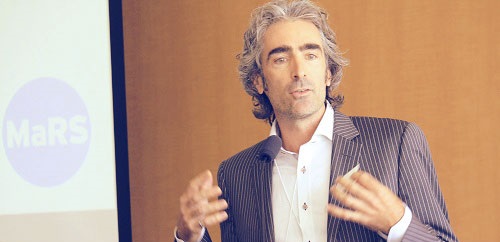
Tom Rand—Cleantech Investor, Advisor, Speaker, Author, Entrepreneur during one of his numerous talks. Photo courtesy of Tom Rand
Tom Rand: First of all, we need to recognize the things that we have done well. Sustainable Development Technology Canada (SDTC) is one of the single most important reasons why Canada has a cleantech sector at all. They have been deploying money intelligently, leveraging private capital, doing really good due diligence for the past 10 years. That’s the basis for the Canadian cleantech industry, so we need to double down on SDTC.
SDTC and Export Development Canada (EDC) recently announced a partnership to try to get cleantech companies to the market. I think the government’s role is to continue to provide support for those kinds of institutions and ensure they are recognized as strategically important.
Green bonds also play a role. [Editor’s note: Green Bonds are a government backed financial instrument designed to raise capital to accelerate renewable energy production. The idea is to raise money from the public, guarantee it by the government, and lend it at low rates to energy producers who choose renewable methods of production.] I think that Canadians have an appetite to do something about solving the problem of climate change, they want to do more than change a light bulb. A green bond is like a ‘victory bond’ for World War II, it engages citizens. So certainly a retail-oriented product like a green bond which is backed by the Canadian government, is a good idea.
Engaging the Canadian public, giving them a seat at the table, and a way to deploy their capital into solving this problem fundamentally changes the political dynamic. Because Canadians are involved, they feel empowered, they put some money on the table, and they see results. It is a very important way for Canadians to engage on climate, doing more than changing the light bulb.
It is very difficult to engage on climate, anybody who looks at this issue — if you are not troubled, if you don’t feel despair — then you don’t understand it. A good example is the recent drought in California, it is getting nasty and Canadians want to do something. They are agitated and green bonds provide a solution; not only do they raise capital and accelerate Canadian technology in the market, they engage the public in a way that has a positive impact on the climate. Unless you give people hope, unless you give people a way to participate in a positive way they will turn away from this issue.
Derick: Won’t all this be expensive?

Tom Rand—Cleantech Investor, Advisor, Speaker, Author, Entrepreneur signing his book “Waking The Frog” for PVBuzz. Photo by Derick Ajumni
Tom Rand: [laughs] Well, first of all, I would argue that doing nothing is the most expensive option. How much money is California losing right now because of that drought, $17 billion last year? This is the appetizer to the main course, if we don’t solve this problem, this economy will not make it past 2050. We will not be able to support 8 billion people on this planet. If you want to talk about expensive, sit and do nothing. You will find how expensive this is going to get.
Derick: Who is going to pay for it?
Tom Rand: First of all, it is not incumbent upon those who are trying to solve this problem to defend the cost, because we need to do it. It is not optional — it is a moral imperative to keep the world safe. That’s what we are doing. That said, my own analysis says the cost is about a coffee and doughnut per person per week to avoid 2.5 degree of warming—that’s with no economic upside. That’s with no benefits from not sending our money to Saudi Arabia for oil, just pure cost. Now if you listen to the skeptics on all this, those who say it’s too expensive, they will say it is between 1% and 2% GDP. I’m not going to argue with that but, I think they are wrong, it’s a net positive to respond to this actually. It’s a kind of payback period but it’s a net gain for us to solve this problem. There is more information about this in my book, Waking the Frog: Solutions for our climate change paralysis.
To switch to renewable resources as a technology base is an economic transition that comes with a net gain. It comes with effort and capital cost but it’s got an economic gain. But forget that. Let’s pretend it doesn’t, let’s take the skeptics at face value, the American Enterprises Institute, the Koch Brothers, or the people who say it’s too expensive. 1% to 2% GDP is what it will cost us. Now if you ask what most people spend to insure their houses? They would probably say $2,000.00/yr. What’s it worth to insure the planet? To ensure that we have a livable planet? 1% to 2% GDP as an insurance cost is too much for us to bear? It’s not. And those costs are from the skeptic’s mouths, not mine. Generations before us paid a lot bigger price than 1% or 2% of GDP to get us here. Whether through conflict, through resource wars, through depressions, they did it. Here we are and all our generation asks is 1% to 2% GDP to solve the biggest existential crisis humans ever faced? I know what my Grandma would say if we say it’s too expensive or too difficult.
The Canadians
Derick: What role should Canada be playing to curb climate change?
Tom Rand: It is a moral issue to lower our emissions, to do the right thing regardless of the economic upside. Canada needs to stand up and take the lead on this issue as we have done in the past. We don’t take the lead anymore—but we did on CFC’s, our Blue Helmeted Peace Keepers, World War I, World War II. We are there; we did our fair share but we have not on climate. e need to review our position and think about climate as a moral question and ask what kind of position Canada takes on this moral question.
So step up, commit to lowering our own emissions, it’s the best way to convince other people to act. You can’t ask China, or India or Bangladesh, to lower their emission if you are not going to step up and do it yourself. Even Ethiopia, rich Ethiopia, has a stronger target of emission reduction than poor Canada. Isn’t that reversed? Shouldn’t we be leading the way and demonstrating to countries like Ethiopia what a developed country can do? That’s why it’s not only a moral question to do it ourselves—but it’s how we get the rest of the world to act too. We earn good faith, show them we are at the table and we are going to solve this problem. We are going to do our fair share.
Tom Rand—Cleantech Investor, Advisor, Speaker, Author, Entrepreneur “Talking oil sands moratorium” with Amanda Lang of the CBC (Video by CBC Canada)
Derick: What role can Canada play with its less than 2% of global carbon emissions?
Tom Rand: The percentage of our global emissions is irrelevant. It is a per capita issue and everyone has to do their fair share. The fact that we are 2% emissions, we are 2% of the population what do you expect? This is a collective active problem; we all have to do our piece.
By that argument I shouldn’t vote, my vote doesn’t make a difference right? I’m only one person in millions, do we ever make the argument you shouldn’t vote? Of course not! It is disingenuous and totally devoid of moral leadership. It’s not about whether we are 2% of the global emissions or not, it’s everyone doing their share. Is there an economic upside to this? I keep arguing that if we get 2% of the global clean energy economy, our cleantech energy would be bigger than our automobile sector. So there is an argument from economic positions alone that depend on our 2%. This is a big market, let’s go after it.
Tom Rand
Tom Rand—is currently a managing partner of Arctern Ventures which is a privately backed venture firm that invests in disruptive clean energy technologies. He is also a senior adviser at MaRs Cleantech, he is an author and speaker about things climate and clean tech related.
— MaRS Discovery District
Derick: I know you developed Planet Traveler, North America’s lowest-carbon hotel in downtown Toronto, and made a number of private investments in the cleantech sector. I also know you are the author of Kick the Fossil Fuel Habit (2009) and Waking the Frog: Solutions to our Climate Paralysis (spring 2014). But can we learn get a little more about Tom Rand—how did you get here? What inspired you?
Tom Rand: I grew up in a scientifically literate household. My father is a professor of biophysics and we’ve had countless table pounding discussions around climate since when I was a kid. This issue has been on the table for a long time and I have always been worried about it.
I had a software company and sold it in 2005; I met some very influential people at that time, people that were very encouraging of me getting into the climate game. But then I think there are a lot of really smart people who get this issue but not everybody who works for a big company can speak publicly the way I speak about it. People don’t want their brands associated with this kind of apocalyptic talk.
So I think many of our businesses are handcuffed, that they can’t really speak openly in public because of the brands they are associated with, there is a little bit of constraint around helping them to speak. I don’t have that constraint; I am independent to some extent.
The Future
Derick: As a speaker, how is the reception of this ‘disruptive’ message? Where do we go from here?
Tom Rand: The biggest problem with climate is that to accept the truth of climate disruption means that we have to rethink most of our world views which are neurology embedded, unconscious, and endemic to our brains. The way we make sense of the world. All that stuff sits unconsciously in our brain and it encodes things like; the future is better than the past, the economy grows forever, and human ingenuity knows no bounds. Especially in the western world, it contains a lot of these culturally embedded notions of progress.
Climate disruption runs counter to all these notions of progress. What we really need to do, is we need to find a way to talk about climate that speaks to our world view. That’s why it is really important to talk about the solutions to climate change because it involves innovation, it involves human ingenuity, it involves forward thinking, and it involves progress. We have to talk about solutions to climate change at the same time we talk about the problem of climate change.
If all we do is talk about the problem of climate change, people’s mental defenses will not let in that belief and that’s why we have been collectively sleepwalking for so long on this issue. The truth of climate disruption runs counter to our implicit unconscious deeply held view of ourselves and we need to change that in order to ensure a sustainable future.




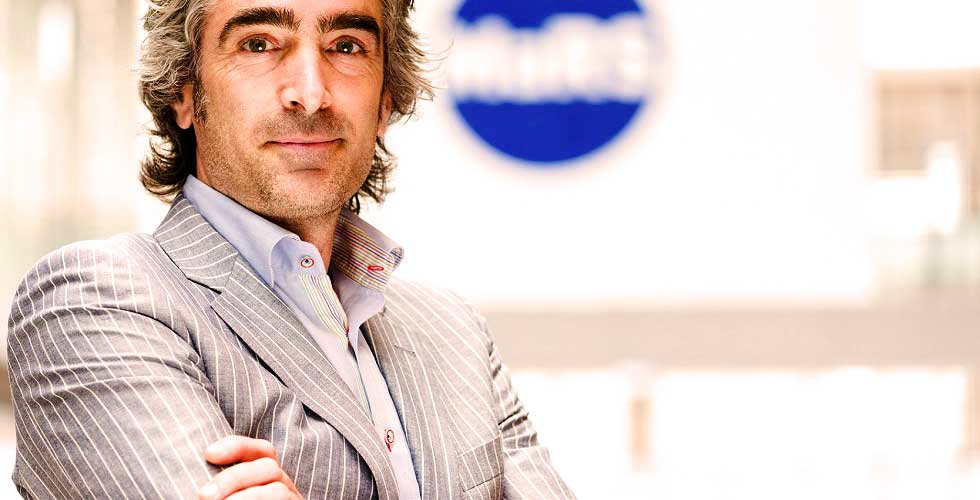
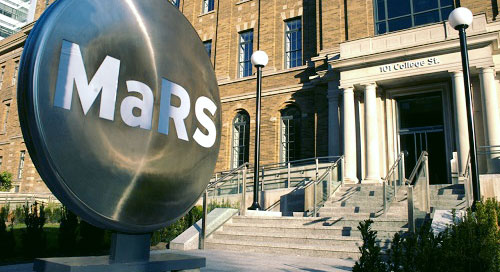


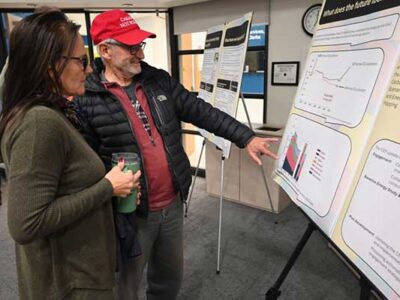







Comments